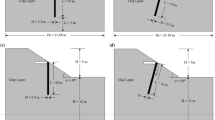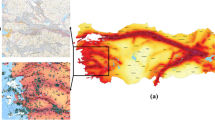Abstract
The response of pile foundation in liquefiable sand reinforced by densification techniques remains a very complex problem during strong earthquakes. A shake-table experiment was carried out to investigate the behavior of a reinforced concrete low-cap pile group embedded in this type of ground. In this study, a three-dimensional (3D) finite element (FE) analysis of the experiment was conducted. The computed response of the soil-pile system was in reasonable agreement with the experimental results, highlighting some key characteristics. Then, a parametric study was performed to explore the influence of pile spacing, pile stiffness (EI), superstructure mass, sand permeability, and shaking characteristics of input motion on the behavior of the pile. The investigation demonstrated a stiffening behavior appearing in the liquefied mediumdense sand, and the pile group effect seemed negligible. Furthermore, the kinematic effect was closely connected with both EI and sand permeability. Nevertheless, the inertial effect was strongly influenced by the superstructure mass. Meanwhile, high frequency and large amplitude of the input motion could produced greater the pile’s moments. It is estimated that this case study could further enhance the current understanding of the behavior of low-cap pile foundations in liquefied dense sand.
Similar content being viewed by others
References
Adalier K, Elgamal A, Meneses J and Baez J (2003), “Stone Columns as Liquefaction Countermeasure in Non-Plastic Silty Soils,” Soil Dynamics and Earthquake Engineering, 23(7):571–584.
Ashford SA, Juirnarongrit T, Sugano T and Hamada M (2006), “Soil–pile Response to Blast-induced Lateral Spreading. I: Field Test,” Journal of Geotechnical and Geoenvironmental Engineering, 132(2): 152–162.
Badoni D and Makris N (1996), “Nonlinear Response of Single Piles under Lateral Inertial and Seismic Loads,” Soil Dynamics and Earthquake Engineering, 15(1): 29–43.
Biot MA (1955), “Theory of Elasticity and Consolidation for a Porous Anisotropic Solid,” Journal of Applied Physics, 26(2): 182–185.
Boulanger RW, Curras CJ, Kutter BL, Wilson DW and Abghari A (1999), “Seismic Soil-pile-structure Interaction Experiments and Analyses,” Journal of Geotechnical and Geoenvironmental Engineering, 125(9): 750–759.
Brandenberg SJ, Boulanger RW, Kutter BL and Chang D (2007), “Liquefaction-induced Softening of Load Transfer Between Pile Groups and Laterally Spreading Crusts,” Journal of Geotechnical and Geoenvironmental Engineering, 133(1): 91–103.
Chae K, Ugai K and Wakai A (2004), “Lateral Resistance of Short Single Piles and Pile Groups Located near Slopes,” International Journal of Geomechanics, 4(2): 93–103.
Chan AH-C (1988), “A Unified Finite Element Solution to Static and Dynamic Problems of Geomechanics,” PhD Thesis, University College of Swansea.
Chau K, Shen C and Guo X (2009), “Nonlinear Seismic Soil–pile–structure Interactions: Shaking Table Tests and Fem Analyses,” Soil Dynamics and Earthquake Engineering, 29(2): 300–310.
Cheng Z and Jeremic B (2009), “Numerical Modeling and Simulation of Pile in Liquefiable Soil,” Soil Dynamics and Earthquake Engineering, 29(11): 1405–1416.
Cubrinovski M, Kokusho T and Ishihara K (2006), “Interpretation from Large-scale Shake Table Tests on Piles Undergoing Lateral Spreading in Liquefied Soils,” Soil Dynamics and Earthquake Engineering, 26(2): 275–286.
Dash SR, Govindaraju L and Bhattacharya S (2009), “A Case Study of Damages of the Kandla Port and Customs Office Tower Supported on a Mat–pile Foundation in Liquefied Soils under the 2001 Bhuj Earthquake,” Soil Dynamics and Earthquake Engineering, 29(2): 333–346.
Dungca JR, Kuwano J, Takahashi A, Saruwatari T, Izawa J, Suzuki H and Tokimatsu K (2006), “Shaking Table Tests on the Lateral Response of a Pile Buried in Liquefied Sand,” Soil Dynamics and Earthquake Engineering, 26(2): 287–295.
Elgamal A and Lu J (2009), “A Framework for 3D Finite Element Analysis of Lateral Pile System Response,” Proceedings of the Contemporary Topics in In Situ Testing, Analysis, and Reliability of Foundations, Orlando, Florida, United States, pp. 616–623.
Elgamal A, Yan L, Yang Z and Conte JP (2008), “Three-dimensional Seismic Response of Humboldt Bay Bridge-foundation-ground System,” Journal of Structural Engineering, 134(7): 1165–1176.
Elgamal A, Yang Z, Parra E and Ragheb A (2003), “Modeling of Cyclic Mobility in Saturated Cohesionless Soils,” International Journal of Plasticity, 19(6): 883–905.
Finn W and Fujita N (2002), “Piles in Liquefiable Soils: Seismic Analysis and Design Issues,” Soil Dynamics and Earthquake Engineering, 22(9): 731–742.
Finn WL and Thavaraj T (2001), “Deep Foundations in Liquefiable Soils: Case Histories, Centrifuge Tests and Methods of Analysis,” Proceedings of the 4th International Conference on Recent Advances in Geotechnical Earthquake Engineering and Soil Dynamics and Symposium in Honour of Professor WD Liam Finn., San Diego, California, pp. 26–31.
Gao X, Ling XZ, Tang L and Xu PJ (2011), “Soil-pilebridge Structure Interaction in Liquefying Ground Using Shake Table Testing,” Soil Dynamics and Earthquake Engineering, 31(7): 1009–1017.
González L, Abdoun T and Dobry R (2009), “Effect of Soil Permeability on Centrifuge Modeling of Pile Response to Lateral Spreading,” Journal of Geotechnical and Geoenvironmental Engineering, 135(1): 62–73.
Haigh SK and Madabhushi S (2011), “Centrifuge Modelling of Pile-soil Interaction in Liquefiable Slopes,” Geomechanics and Engineering, 3: 1–16.
He L, Elgamal A, Abdoun T, Abe A, Dobry R, Hamada M, Menses J, Sato M, Shantz T and Tokimatsu K (2009), “Liquefaction-induced Lateral Load on Pile in a Medium Dr Sand Layer,” Journal of Earthquake Engineering, 13(7): 916–938.
Iai S, Morita T, Kameoka T, Matsunaga Y and Abiko K (1995), “Response of a Dense Sand Deposit During 1993 Kushiro-Oki Earthquake,” Soils and Foundations, 35(1): 115–131.
Knappett J and Madabhushi S (2008), “Liquefaction-Induced Settlement of Pile Groups in Liquefiable and Laterally Spreading Soils,” Journal of Geotechnical and Geoenvironmental Engineering, 134(11): 1609–1618.
Law HK and Lam IP (2001), “Application of Periodic Boundary for Large Pile Group,” Journal of Geotechnical and Geoenvironmental Engineering, 127(10): 889–892.
Liu C, Soltani H, Pinilla JD, Muraleetharan KK, Cerato AB and Miller GA (2011), “Centrifuge Investigation of Seismic Behavior of Pile Foundations in Soft Clays,” Proceedings of the Geo-Frontiers 2011 conference, Dallas, Texas, United States, pp. 585–594.
Lu J, Elgamal A, Yan L, Law KH and Conte JP (2011), “Large-scale Numerical Modeling in Geotechnical Earthquake Engineering,” International Journal of Geomechanics, 11(6): 490–503.
Maheshwari B, Truman K, El Naggar M and Gould P (2004), “Three-dimensional Nonlinear Analysis for Seismic Soil–pile-structure Interaction,” Soil Dynamics and Earthquake Engineering, 24(4): 343–356.
Maheshwari B, Truman K, Gould P and El Naggar M (2005), “Three-dimensional Nonlinear Seismic Analysis of Single Piles Using Finite Element Model: Effects of Plasticity of Soil,” International Journal of Geomechanics, 5(1): 35–44.
Maheshwari B and Watanabe H (2006), “Nonlinear Dynamic Behavior of Pile Foundations: Effects of Separation at the Soil-pile Interface,” Soils and Foundations, 46(4): 437–448.
Mazzoni S, McKenne F, Scott M and Fenves G (2009), “Open System for Earthquake Engineering Simulation User Manual Version 2.1.0,” Berkeley, CA, University of California, Pacific Earthquake Engineering Center, USA.
Mitchell JK (2008), “Mitigation of Liquefaction Potential of Silty Sands,” Proceedings of the From Research to Practice in Geotechnical Engineering, New Orleans, Louisiana, United States, pp. 433–451.
Motamed R and Towhata I (2010), “Shaking Table Model Tests on Pile Groups Behind Quay Walls Subjected to Lateral Spreading,” Journal of Geotechnical and Geoenvironmental Engineering, 136(3): 477–489.
Nogami T, Otani J, Konagai K and Chen H (1992), “Nonlinear Soil-pile Interaction Model for Dynamic Lateral Motion,” Journal of Geotechnical Engineering, 118(1): 89–106.
Ohtsuki A, Fukutake K, Fujikawa S and Sato M (1994), “Three Dimensional Effective Analysis for Evaluating Response of Group Pile Foundation under Liquefaction,” Journal of Structural Mechanics and Earthquake Engineering, (495): 101–110.
Palermo A, Wotherspoon L, Wood J, Chapman H, Scott A, Hogan L, Kivell A, Camnasio E, Yashinsky M and Bruneau M (2011), “Lessons Learnt from 2011 Christchurch Earthquakes: Analysis and Assessment of Bridges,” Bulletin of the New Zealand Society for Earthquake Engineering, 44(4): 319–333.
Parra E (1996), “Numerical Modeling of Liquefaction and Lateral Ground Deformation Including Cyclic Mobility and Dilation Response in Soil Systems,” PhD Thesis, Rensselaer Polytechnic Institute.
Rayamajhi D, Nguyen TV, Ashford SA, Boulanger RW, Lu J, Elgamal A and Shao L (2014), “Numerical Study of Shear Stress Distribution for Discrete Columns in Liquefiable Soils,” Journal of Geotechnical and Geoenvironmental Engineering, 140(3):04013034.
Rollins KM, Gerber TM, Lane JD and Ashford SA (2005), “Lateral Resistance of a Full-scale Pile Group in Liquefied Sand,” Journal of Geotechnical and Geoenvironmental Engineering, 131(1): 115–125.
Tang L, Ling XZ, Xu PJ, Gao X and Wang DS (2010), “Shake Table Test of Soil-pile groups-bridge Structure Interaction in Liquefiable Ground,” Earthquake Engineering and Engineering Vibration, 9(1): 39–50.
Towhata I, Sesov V, Motamed R and Gonzalez M (2006), “Model Tests on Lateral Earth Pressure on Large Group Pile Exerted by Horizontal Displacement of Liquefied Sandy Ground,” Proceedings of the Eighth US National Conference on Earthquake Engineering and 100th Anniversary Earthquake Conference, San Francisco, California, pp. 18–22.
Uzuoka R, Cubrinovski M, Sugita H, Sato M, Tokimatsu K, Sento N, Kazama M, Zhang F, Yashima A and Oka F (2008), “Prediction of Pile Response to Lateral Spreading by 3-D Soil–Water Coupled Dynamic Analysis: Shaking in the Direction Perpendicular to Ground Flow,” Soil Dynamics and Earthquake Engineering, 28(6): 436–452.
Wang S, Kutter BL, Chacko MJ, Wilson DW, Boulanger RW and Abghari A (1998), “Nonlinear Seismic Soil-Pile Structure Interaction,” Earthquake Spectra, 14(2): 377–396.
Weaver TJ, Ashford SA and Rollins KM (2005), “Response of 0.6 M Cast-in-Steel-Shell Pile in Liquefied Soil under Lateral Loading,” Journal of Geotechnical and Geoenvironmental Engineering, 131(1): 94–102.
Wotherspoon LM, Pender MJ and Orense RP (2012), “Relationship between Observed Liquefaction at Kaiapoi Following the 2010 Darfield Earthquake and Former Channels of the Waimakariri River,” Engineering Geology, 125: 45–55.
Wriggers P (2002), Comput ational Contact Mechanics, John Wiley&Sons, Hoboken, New Jersey.
Yang Z (2000), “Numerical Modeling of Earthquake Site Response Including Dilation and Liquefaction,” PhD Thesis, Columbia Univ., New York.
Yang Z, Elgamal A and Parra E (2003), “Computational Model for Cyclic Mobility and Associated Shear Deformation,” Journal of Geotechnical and Geoenvironmental Engineering, 129(12): 1119–1127.
Yang Z and Jeremic B (2003), “Numerical Study of Group Effects for Pile Groups in Sands,” International Journal for Numerical and Analytical Methods in Geomechanics, 27(15): 1255–1276.
Yen PW, Chen G, Buckle I, Allen T, Alzamora D, Ger J and Arias J (2011), “Bridge Performance During the 2010 M8.8 Chile Earthquake,” Proceedings of the Structures Congress 2011, Las Vegas, Nevada, United States, pp. 1649–1659.
Zeghal M and Elgamal A (1994), “Analysis of Site Liquefaction Using Earthquake Records,” Journal of Geotechnical Engineering, 120(6): 996–1017.
Zhang F and Kimura M (2002), “Numerical Prediction of the Dynamic Behaviors of an RC Group-pile Foundation,” Soils and Foundations, 42(3): 77–92.
Zienkiewicz O, Chan A, Pastor M, Paul D and Shiomi T (1990), “Static and Dynamic Behaviour of Soils: A Rational Approach to Quantitative Solutions. I. Fully Saturated Problems,” Proceedings of the Royal Society of London. A. Mathematical and Physical Sciences, 429(1877): 285–309.
Author information
Authors and Affiliations
Corresponding author
Additional information
Supported by: National Natural Science Foundation of China under Grant Nos. 51108134 and 51378161
Rights and permissions
About this article
Cite this article
Tang, L., Zhang, X., Ling, X. et al. Experimental and numerical investigation on the dynamic response of pile group in liquefying ground. Earthq. Eng. Eng. Vib. 15, 103–114 (2016). https://doi.org/10.1007/s11803-016-0308-2
Received:
Accepted:
Published:
Issue Date:
DOI: https://doi.org/10.1007/s11803-016-0308-2




